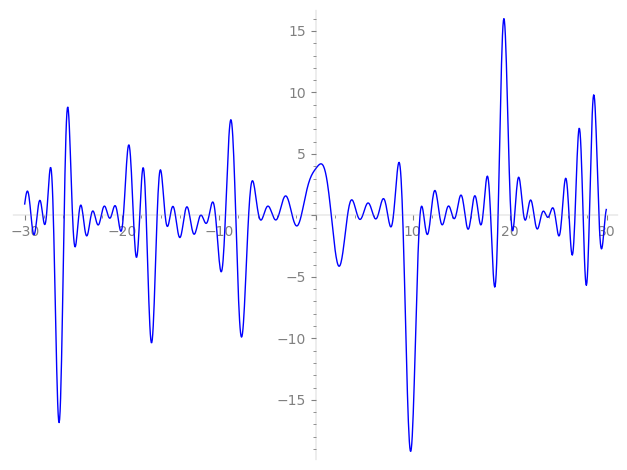| L(s) = 1 | + (2.21 − 1.28i)2-s + (−0.866 + 0.5i)3-s + (2.28 − 3.95i)4-s + (−1.28 + 2.21i)6-s + (3.08 + 1.78i)7-s − 6.56i·8-s + (0.499 − 0.866i)9-s + (1 + 1.73i)11-s + 4.56i·12-s + (3.57 − 0.5i)13-s + 9.12·14-s + (−3.84 − 6.65i)16-s + (−2.21 − 1.28i)17-s − 2.56i·18-s + (−0.561 + 0.972i)19-s + ⋯ |
| L(s) = 1 | + (1.56 − 0.905i)2-s + (−0.499 + 0.288i)3-s + (1.14 − 1.97i)4-s + (−0.522 + 0.905i)6-s + (1.16 + 0.673i)7-s − 2.31i·8-s + (0.166 − 0.288i)9-s + (0.301 + 0.522i)11-s + 1.31i·12-s + (0.990 − 0.138i)13-s + 2.43·14-s + (−0.960 − 1.66i)16-s + (−0.538 − 0.310i)17-s − 0.603i·18-s + (−0.128 + 0.223i)19-s + ⋯ |
Λ(s)=(=(975s/2ΓC(s)L(s)(0.450+0.892i)Λ(2−s)
Λ(s)=(=(975s/2ΓC(s+1/2)L(s)(0.450+0.892i)Λ(1−s)
| Degree: |
2 |
| Conductor: |
975
= 3⋅52⋅13
|
| Sign: |
0.450+0.892i
|
| Analytic conductor: |
7.78541 |
| Root analytic conductor: |
2.79023 |
| Motivic weight: |
1 |
| Rational: |
no |
| Arithmetic: |
yes |
| Character: |
χ975(874,⋅)
|
| Primitive: |
yes
|
| Self-dual: |
no
|
| Analytic rank: |
0
|
| Selberg data: |
(2, 975, ( :1/2), 0.450+0.892i)
|
Particular Values
| L(1) |
≈ |
3.23921−1.99380i |
| L(21) |
≈ |
3.23921−1.99380i |
| L(23) |
|
not available |
| L(1) |
|
not available |
L(s)=p∏Fp(p−s)−1 | p | Fp(T) |
|---|
| bad | 3 | 1+(0.866−0.5i)T |
| 5 | 1 |
| 13 | 1+(−3.57+0.5i)T |
| good | 2 | 1+(−2.21+1.28i)T+(1−1.73i)T2 |
| 7 | 1+(−3.08−1.78i)T+(3.5+6.06i)T2 |
| 11 | 1+(−1−1.73i)T+(−5.5+9.52i)T2 |
| 17 | 1+(2.21+1.28i)T+(8.5+14.7i)T2 |
| 19 | 1+(0.561−0.972i)T+(−9.5−16.4i)T2 |
| 23 | 1+(1.73−i)T+(11.5−19.9i)T2 |
| 29 | 1+(2.84+4.92i)T+(−14.5+25.1i)T2 |
| 31 | 1+1.56T+31T2 |
| 37 | 1+(−2.97+1.71i)T+(18.5−32.0i)T2 |
| 41 | 1+(1.28+2.21i)T+(−20.5+35.5i)T2 |
| 43 | 1+(−0.379−0.219i)T+(21.5+37.2i)T2 |
| 47 | 1+8.24iT−47T2 |
| 53 | 1+11.6iT−53T2 |
| 59 | 1+(5.56−9.63i)T+(−29.5−51.0i)T2 |
| 61 | 1+(6.06−10.4i)T+(−30.5−52.8i)T2 |
| 67 | 1+(−0.379+0.219i)T+(33.5−58.0i)T2 |
| 71 | 1+(7−12.1i)T+(−35.5−61.4i)T2 |
| 73 | 1−1.87iT−73T2 |
| 79 | 1+9.56T+79T2 |
| 83 | 1−9.12iT−83T2 |
| 89 | 1+(−6.56−11.3i)T+(−44.5+77.0i)T2 |
| 97 | 1+(−3.84−2.21i)T+(48.5+84.0i)T2 |
| show more | |
| show less | |
L(s)=p∏ j=1∏2(1−αj,pp−s)−1
Imaginary part of the first few zeros on the critical line
−10.33406379978787693962128654566, −9.305147586573910571060499595304, −8.243162938039922743841372916094, −6.91697214075337980506260824994, −5.87587823253042500150131451295, −5.38143042501547737118817396027, −4.43171502086696322807791983433, −3.82533939277645362843121951178, −2.42242174595223865497055331108, −1.48692520106216810671316459752,
1.60360467727692540339279648819, 3.27673836410607749528869622382, 4.30426859820601916826247569271, 4.84052266981001478327102447705, 5.95152448154802315811676070114, 6.41662221913434678374831985197, 7.43131096360612999864611153862, 8.010350929940172427547605295191, 8.960256857157523890267652242431, 10.74960932783229664605515057565

